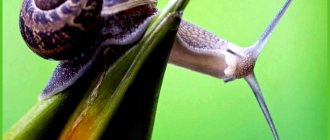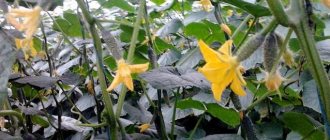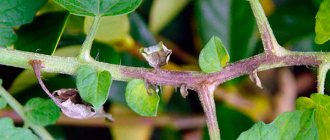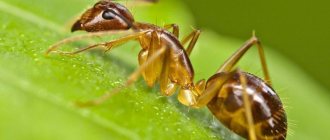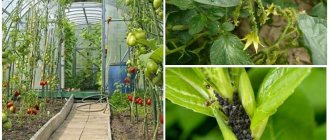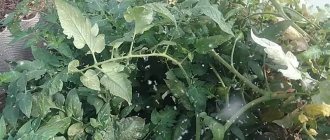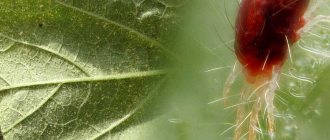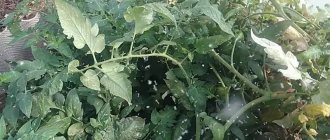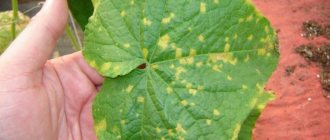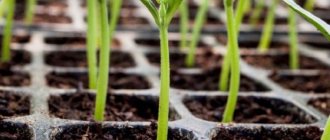Aphids are dangerous harmful insects that live in symbiosis with ants. The presence of the latter on the site is one of the main reasons for the colonization of plants by pest colonies. You can fight aphids in cucumber plantings using both chemical and biological methods of protection, as well as traditional methods. The last thing to treat is the bushes after flowering. Although less effective, it is safer than using pesticides.
What aphid affects cucumbers?
Planting cucumbers in closed and open ground is affected by green and black aphids. The length of the bugs is 2-5 mm. The body is soft, covered with growths and hairs of varying lengths. The antennae are located on the forehead, and the organs of touch are located on them.
The oral apparatus is represented by a proboscis, with which the aphid bites through the plant tissue and sucks out the juice. The legs are long and thin, performing walking and jumping functions. On the abdomen there are juice tubes that secrete honeydew.
The insect adapts to any weather conditions . Asexual females reproduce at lightning speed. During the summer, they lay 50 eggs at a time.
Colonies accumulate on the upper leaves, the lower leaves are too dense for them. Therefore, superficial treatments are sufficient to kill insects. In spring, when the air warms up to +5 °C, aphids become active.
When drinking juice from leaves, aphids secrete a sticky coating, which leads to impaired photosynthesis and the development of a bacterial infection.
Description of the pest
It’s worth clarifying right away that there is no separate family called “black aphid.” This is what people call aphid species with black, dark blue and green-brown colors. The pest is a tiny insect, not exceeding 5 mm in size.
Did you know? Insects appeared on Earth much earlier than other animals - approximately 400 million years before the present day. The endurance of these small creatures is so high that they are able to survive any disaster. Even if humanity exterminates itself, it is unlikely that it will be able to completely destroy insects.
To procreate, the female black aphid does not require the reproductive cells of a male individual, so these parasites reproduce at high speed. The female lays eggs on the food vegetation itself, where they can safely overwinter.
The life cycle of aphids is very short - after reaching maturity, the individual lives only 2 weeks. During this short period, the female is able to lay up to 150 eggs. The larvae begin to parasitize immediately after hatching.
Aphids usually settle on the bottom of leaves, where they feed on the juice of young cucumber leaves and shoots rich in carbohydrates and individual amino acids. The insect is endowed with a special proboscis, with the help of which it can suck juice from fairly thick plant skins.
Determining the presence of aphids is not difficult. Small pests can be found on leaves, flowers, ovaries and shoots of garden crops. Often, aphids first attack the weeds around the garden, then the aphids successfully move onto vegetables.
We recommend reading
How to grow cucumbers correctly The threat of black aphids lies in the high density of their accumulation on the bush. Due to lack of food, they have to fly from bush to bush. A mass of individuals attack a leaf plate or other part of the plant, pierce its surface and allow bacteria access there.
When infected with fungal spores, the plant begins to rot rapidly. Aphids drain all their strength from the tissues of seedlings; as a result, the garden crop dies before it has time to bear fruit.
Reasons for appearance
Wingless females and larvae of aphids spend the winter in the remains of weeds. With the onset of spring, pests become more active and move to existing plants in the garden, which include vegetable crops. Usually this time coincides with the planting of seedlings in a permanent place.
Aphids settle on seedlings planted in open beds or in a greenhouse. In the first case, it affects cucumbers in June. If the seedlings are planted in a greenhouse or greenhouse, infection occurs at the end of April or in May.
Favorable conditions for the spread of aphids are:
- refusal to observe crop rotation;
- abundance of weeds in the beds;
- thickening of plantings;
- poor soil preparation before planting seedlings;
- presence of ants on the site.
Symptoms of the lesion
At the initial stage of infection, it is difficult to see small bugs merging with the greenery. But as the aphids spread in the area, the first symptoms appear:
- plants are delayed in growth and development;
- flowering begins much later than expected;
- the upper leaves first wither, then dry and curl;
- droplets of liquid appear on the leaves - honey dew;
- a large number of ants appear on the site;
- the ovaries dry out and fall off;
- the lower leaves fade;
- the reverse side of the leaves seems to be covered with green or black bugs.
The photo shows cucumber leaves infected with aphids.
Why are aphids dangerous for cucumbers?
Damage by this parasite is common to almost all pumpkin crops, including cucumbers. Of the huge number of varieties of this pest, the melon aphid most often settles on cucumber crops.
The size of the insect is small, its body length does not exceed 2 mm, but the damage it causes to plants is enormous. The main difference between the parasite is that it actively reproduces and is able to occupy most of the beds in just a couple of days.
The damage caused by melon aphids to cucumbers is expressed as follows:
- The insect pierces the cucumber leaves, leaving numerous holes and sucking all the juices from the leaf blades. As a result, the growth of the crop and its development slows down, the formation of fruits is significantly reduced, and the plant sooner or later withers and dies.
- Aphids can be carriers of dangerous infections. When it affects a crop, it infects it with one of the dangerous diseases, which leads to even more disastrous results and large-scale damage.
Fighting aphids on cucumbers
In the greenhouse and in open beds, different control methods are used to destroy aphids. There are several ways to combat this pest:
- The safest products are those prepared based on folk recipes. They give a good effect against aphids on cucumbers in a greenhouse and in open beds if the insects have just begun to spread.
- Biological agents are used to treat individual bushes. They contain live bacteria that kill pests. An additional effect of biological products is to stimulate plant growth.
- Chemicals are used in cases of mass infection. They act quickly and get rid of aphids for a long time. Their disadvantage is toxicity. Therefore, during the period of fruit ripening, it is better to avoid using them.
It is necessary to fight both aphids on cucumbers in the greenhouse and ants. Otherwise, the infection may recur. Usually their anthills are located next to cucumber beds or right on them.
Tips and tricks
To summarize, we can give the following tips and recommendations from experienced gardeners regarding issues of aphid control:
- When weeding the beds, you should not put off throwing out weeds until later, since storing them near the plants being grown also creates good conditions for these pests to live in.
- When fighting aphids, it is recommended to simultaneously destroy all anthills and get rid of their inhabitants, since they often protect these pests and hide them in their homes.
- For chemical destruction, the combined use of insecticides that have contact, intestinal and other means of action is recommended. This increases the chances of poisoning the majority of individuals in the colony and spreading a global epidemic.
- When carrying out the procedure for treating cucumber seedlings with toxic substances, it is necessary to remember the safety of children and pets, preventing their contact with these plants.
Folk remedies for aphids on cucumbers
There are many ways to fight aphids on cucumbers from the bottom of the leaves using traditional recipes. They use safe but effective substances as active ingredients. Bushes are treated 2-3 times a week. In this case, it is necessary to alternate means for maximum effectiveness.
Mustard
One method of pest control is the use of dry mustard powder. It effectively destroys aphids and promotes active fruiting of cucumbers, enriching the soil with useful elements. To treat plants, dissolve 120 g of dry mustard in 10 liters of warm water. After mixing thoroughly, spray the bushes with the liquid. The underside of the leaves is treated especially carefully. The procedure is repeated at least three times with a break of 2-3 days.
Baking soda
Another means of combating insects is treatment with soda solution. Baking soda protects cucumber bushes and gets rid of fungi, bacteria and viruses. Additionally, it benefits the plant by prolonging the fruiting period and improving the taste of greens. To make the solution, 60 g of soda powder is dissolved in a bucket of water. The liquid is used to spray bushes. To improve efficiency, add a little crushed laundry soap to the working solution.
Ammonia
Protecting cucumbers with ammonia is safe and effective. The composition with ammonia acts quickly. To destroy most pests, it is enough to spray once every 2 weeks. In addition, ammonia acts as a nitrogen supplement. The solution is prepared by mixing 50 ml of ammonia with 10 liters of cold water. To improve adhesion, add a little liquid or laundry soap. You need to spray the bushes from all sides with this liquid.
Hydrogen peroxide
Another method for dealing with black aphids on cucumbers is the use of peroxide. To prepare the working solution, mix 1 liter of cold water, 60 g of granulated sugar and 60 ml of hydrogen peroxide. To save cucumber bushes from pest invasion, you need to spray them with the resulting liquid. Treatment is carried out weekly.
Vinegar for aphids
Solutions with vinegar work well against parasites. To protect plants, they need to be treated every 3 days. The solution is made from 3 liters of water and 15 ml of table vinegar with a concentration of 6%. For maximum effect, add laundry soap to the solution. The product is sprayed onto the plants from a sprayer or simply watered the bushes from a watering can.
Wood ash
To get rid of aphids on cucumbers, wood ash is often used. It irritates insects, forcing them to move to another place. Under the influence of the components of the solution, the taste of the plant juice changes. As a result, it becomes unsuitable for insect nutrition.
To get rid of pests, wood ash is used in several ways:
- The treatment solution is prepared from 10 liters of warm water and 1 cup of ash. The liquid is left to infuse for 24 hours. Then add a little shavings of laundry soap into it. You need to water the ground under the greenhouse bushes with the prepared solution or spray the plants.
- You can prepare a decoction faster. For it, 1 glass of ash is mixed with 2 liters of water and boiled over low heat for half an hour. Then add clean water to a volume of 10 liters and add laundry soap.
- You can mix 1 cup of ash with 1 cup of crushed tobacco. This mass is poured with 10 liters of hot water and left to brew for 24 hours.
- You can simply dust the plants with crushed wood ash.
Soap solutions
To remove pests from cucumber leaves, many vegetable growers use laundry soap. It helps remove aphids and repels other pests. The block is grated and mixed with boiling water until the particles dissolve. Then dilute with cool water to a volume of 10 liters. The prepared solution is sprayed onto infected bushes. Instead of laundry soap, you can use tar soap. In this case, 100 g of the substance per 10 liters of water is sufficient.
Garlic infusion
To prepare the garlic solution, chop 2 heads of garlic and mix with 10 liters of boiling water. The liquid is left to infuse for 24 hours. Then the infusion is filtered and used to treat the bushes and water the ground under them.
Onion peel
Onion scales contain many useful substances. Therefore, with its help at home you can eliminate the pest, give plants additional nutrition, and increase resistance against certain diseases.
To make a healthy infusion, 250 g of onion peels are brewed in 10 liters of boiling water and left to brew for 3 days. Then the liquid is filtered and the bushes are treated with it from a sprayer. You can boil the husks in a small amount of water for 5 minutes over low heat. Then cool and dilute with water to the required volume. Then the solution can be used to process cucumbers without infusion.
Pine extract
To prepare this solution you will need 1 tbsp. a spoonful of pine extract per 10 liters of water, as well as 2-3 tbsp. spoons of liquid soap.
Tobacco dust
This remedy for combating aphids can rather be classified as biological than folk.
An infusion of tobacco dust is made as follows: take 2 glasses of tobacco dust, add 10 liters of water, and infuse for 24 hours. Then the resulting infusion is filtered and 50 grams (2-3 tablespoons) of grated laundry soap are also added to it.
In addition to the infusion, you can prepare a decoction of tobacco dust in a similar way by boiling it for half an hour.
In general, tobacco dust is a fairly reliable means of combating many other garden pests.
Biological products
Special preparations have been developed for vegetables that do not cause significant harm to beneficial insects and humans.
- Spark Bio (Akarin). Unlike other insecticides, effectiveness remains at temperatures of 28 °C and above. This allows the drug to be used in greenhouses and greenhouses with cucumbers. For spraying, dilute 8 ml of concentrate in 1 liter of water. 1-1.5 liters of solution are used per bush.
- Fitoverm. A biological product based on fungal metaplasma begins to act after 12 hours. Destroys only adult individuals, ineffective against larvae. To completely exterminate aphids on cucumbers, it is necessary to carry out 3 treatments with an interval of 14 days. The solution is prepared from 5 ml of Fitoverm, diluted in 1 liter of water.
- Biotlin. The active ingredient of the drug is a concentrated tobacco extract. The death of the pest occurs as a result of paralysis. The effect is noticeable 2-3 hours after spraying. You only need to dilute 5 ml of the drug and 10 liters of water.
When working with the listed products, it is recommended to strictly adhere to the consumption rate of the finished substance, use a mask and gloves. Vegetables can be eaten 2 days after spraying.
Chemicals against aphids on cucumbers
As a rule, after applying several treatments against aphids using folk or biological means, the pests disappear. But if suddenly the cucumbers are still infected, and you don’t want to be left completely without a harvest, you will have to use chemical insecticides.
Chemicals are not used from the moment the ovaries appear due to the active absorption of toxic substances by roots and fruits. Such a crop is dangerous to use for food.
These include agents with contact-intestinal action:
- "Decis" comes into effect an hour after treatment and is not phytotoxic.
- "Inta-Vir" is available in powder and tablet form. Quickly and effectively destroys the pest (protection up to 15 days).
- "Aktara" is a long-acting enteric contact drug (protection up to two months).
- "Tanrek" is a systemic drug with a long period of protection (up to 30 days).
- "Danadim" is a slightly toxic insecticide that gets rid of aphids within 48 hours.
- "Confidor" - begins to work 72 hours after spraying the bushes, is considered one of the most effective insecticides against aphids.
Try various means and preparations, and you will definitely find the best ways to rid your cucumber beds and greenhouses of a formidable enemy called melon aphid. And then you will certainly have a rich harvest.
The best are considered:
- "Bitoxibacillin" - contains the bacteria Bacillus thuringiensis var. thuringiensis, which infect the pest, does not harm the environment.
- "Aquarin" - destroys bugs in 48 hours. The product is used no more than three times per season.
- "Aktofit" and "Fitoverm" - contain aversectin. The toxin negatively affects the nervous system of the insect and completely paralyzes it. The product is not addictive, unlike chemicals.
- "Entobacterin" - contains the bacterium Bacillus thuringiensis var. galleriae Destroys the pest in a week.
- "Arrow" - contains bitoxybacillin, which deprives insects of the opportunity to feed. Completely kills aphids in 10 days.
Common mistakes
- Incorrect dosage for spraying cucumbers. If the concentration of the product is low, it will not be effective, and if it is high, the plant may die.
- Carrying out processing during the daytime. Spray the plants only in the morning and evening to avoid sunburn due to water remaining on the leaves of the cucumbers.
- Too frequent processing. Plants must be sprayed according to the recommendations for the use of drugs. Use folk remedies no more than once a week.
Preventive methods
Urgent protective treatments often require aggressive measures to combat aphids, which will multiply very quickly, causing irreparable damage to plantings. It is better to protect cucumbers from pest attacks in advance by following agricultural practices for growing this crop. Basic preventive measures:
- When preparing a site for cucumbers in the fall, remove all plant debris that can serve as bedding for the pest’s overwintering stock, and during digging, water the soil with a solution of copper sulfate to destroy larvae and pathogenic organisms.
- Introduce the crop into garden crop rotation without planting it after bad predecessors, as a result of which numerous specialized pests and diseases remain on the site.
- During the growing season, destroy weeds, which are an intermediate link for the migration of aphids to cucumbers.
- Apply integrated plant protection, including biological methods - placing nearby garlic, which repels aphids, or mustard, which attracts ladybugs.
- Fight ants and do not place beds near their “homes”.
An important agrotechnical measure that helps protect the cucumber crop from aphids is fertilizing. Thanks to the timeliness of their application, the bushes have excellent immunity. The first feeding is carried out 14 days after planting the seedlings in open ground or the emergence of seedlings using a mullein solution in a ratio of 1: 10. This accelerates the rooting and development of green mass. Further, during the flowering and fruiting phases, fertilizing irrigations with the inclusion of superphosphate and potassium sulfate are used, which improve plant health and extend the harvest period. It is impossible to be late with nitrogen-containing fertilizing, since in this case it can, on the contrary, cause a meager harvest. Aphids are a dangerous pest that colonizes vegetable plantings very quickly. The best solution is to spray the plants as a preventive measure and get a rich harvest of high-quality greens.
